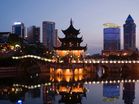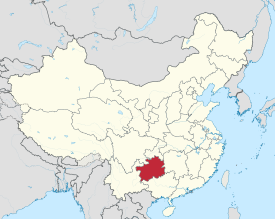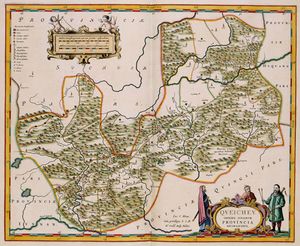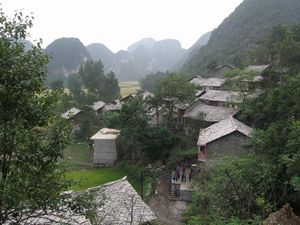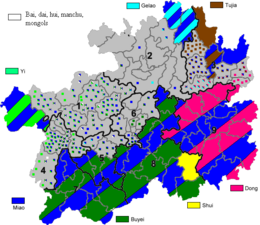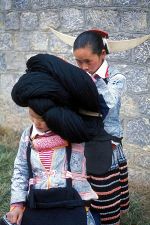قويتشو
| ||||||||||||||||||||||||||||||||||||||||||||||||||||||||||||||||||||||||||
| ||||||||||||||||||||||||||||||||||||||||||||||||||||||||||||||||||||||||||
گويژو أو قويتشو (الصينية المبسطة: 贵州; الصينية التقليدية: 貴州; پنين: Gùizhōu; Wade–Giles: Kuei-chou; وتنطق أيضا Kweichow)، هي مقاطعة في الصين. تقع في الجزء الجنوب الغربي من البلاد. وعاصمتها هي مدينة گوييانگ، في وسط المقاطعة. Guizhou borders the autonomous region of گوانگشي to the south, يوننان to the west, سيتشوان to the northwest, the municipality of Chongqing to the north, and هونان to the east. The population of Guizhou stands at 38.5 million, ranking 18th among the provinces in China.
The Dian Kingdom, which inhabited the present-day area of Guizhou, was annexed by the Han dynasty in 106 BC.[5] Guizhou was formally made a province in 1413 during the Ming dynasty. After the overthrow of the Qing in 1911 and following the Chinese Civil War, the Chinese Communist Party took refuge in Guizhou during the Long March between 1934 and 1935.[6] After the establishment of the People's Republic of China, Mao Zedong promoted the relocation of heavy industry into inland provinces such as Guizhou, to better protect them from potential foreign attacks.[بحاجة لمصدر]
Guizhou is rich in natural, cultural and environmental resources. Its natural industry includes timber and forestry, and the energy and mining industries constitute an important part of its economy. Notwithstanding, Guizhou is considered a relatively undeveloped province, with the fourth-lowest GDP per capita in China as of 2020. However, it is also one of China's fastest-growing economies.[7] The Chinese government is looking to develop Guizhou as a data hub.[8][9]
Guizhou is a mountainous province, with its higher altitudes in the west and centre. It lies at the eastern end of the Yungui Plateau. Demographically, it is one of China's most diverse provinces. Minority groups account for more than 37% of the population, including sizable populations of the Miao, Bouyei, Dong, Tujia and Yi peoples, all of whom speak languages distinct from Chinese. The main language spoken in Guizhou is Southwestern Mandarin, a variety of Mandarin.
الاسم
The area was first organized as an administrative region of a Chinese empire under the Tang, when it was named Juzhou (矩州), pronounced Kjú-jyuw in the Middle Chinese of the period.[10] During the Mongol-led Yuan dynasty, the character 矩 (ju, "carpenter's square") was changed to the more refined 貴 (gui, "precious or expensive").[10] The region formally became a province in 1413, with an eponymous capital then also called "Guizhou" but now known as Guiyang.[10]
التاريخ
Evidence of settlement by humans during the Middle Palaeolithic is indicated by stone artefacts, including Levallois pieces, found during archaeological excavations at Guanyindong Cave. These artefacts have been dated to approximately 170,000–80,000 years ago using optically stimulated luminescence methods.[11]
From around 1046 BCE to the emergence of the State of Qin, northwest Guizhou was part of the State of Shu.[6] During the Warring States period, the Chinese state of Chu conquered the area, and control later passed to the Dian Kingdom. During the Chinese Han Dynasty (206 BCE–220 CE), to which the Dian was tributary, Guizhou was home to the Yelang collection of tribes, which largely governed themselves before the Han consolidated control in the southwest and established the Lingnan province.[6] During the Three Kingdoms period, parts of Guizhou were governed by the Shu Han state based in Sichuan, followed by Cao Wei (220–265) and the Jin Dynasty (265–420).[6]
During the 8th and 9th centuries in the Tang dynasty, Chinese soldiers moved into Guizhou (Kweichow) and married native women. Their descendants are known as Lǎohànrén (老汉人), in contrast to new Chinese who populated Guizhou at later times. They still speak an archaic dialect.[12] Many immigrants to Guizhou were descended from these soldiers in garrisons who married these pre-Chinese women.[13]
Kublai Khan and Möngke Khan conquered the Chinese southwest in the process of defeating the Song during the Mongol invasion of China, and the newly established Yuan dynasty (1279–1368) saw the importation of Chinese Muslim administrators and settlers from Bukhara in Central Asia.[6]
It was during the following Ming dynasty, which was once again led by Han Chinese, that Guizhou was formally made a province in 1413. The Ming established many garrisons in Guizhou from which to pacify the Yao and Miao minorities during the Miao Rebellions.[6] Chinese-style agriculture flourished with the expertise of farmers from Sichuan, Hunan and its surrounding provinces into Guizhou. Wu Sangui was responsible for the ousting the Ming in Guizhou and Yunnan during the Manchu conquest of China. During the governorship-general of the Qing Dynasty's nobleman Ortai, the tusi system of indirect governance of the southwest was abolished, prompting rebellions from disenfranchised chieftains and the further centralization of government. After the Second Opium War, criminal triads set up shop in Guangxi and Guizhou to sell British opium. For a time, Taiping Rebels took control of Guizhou, but they were ultimately suppressed by the Qing.[6] Concurrently, Han Chinese soldiers moved into the Taijiang region of Guizhou, married Miao women, and their children were brought up as Miao.[14][15]
More unsuccessful Miao rebellions occurred during the Qing, in 1735, from 1795–1806[16] and from 1854–1873.[17] After the overthrow of the Qing in 1911 and following Chinese Civil War, the Communists took refuge in Guizhou during the Long March (1934–1935).[6] While the province was formally ruled by the Guomindang warlord Wang Jialie, the Zunyi Conference in Guizhou established Mao Zedong as the leader of the Communist Party. As the Second Sino-Japanese War pushed China's Nationalist Government to its southwest base of Chongqing, transportation infrastructure improved as Guizhou was linked with the Burma Road.[18] After the end of the War, a 1949 Revolution swept Mao into power, who promoted the relocation of heavy industry into inland provinces such as Guizhou, to better protect them from Soviet and American attacks. The 1957 influenza pandemic started in Guizhou and killed a million people around the world. After the Chinese economic reform began in 1978, geographical factors led Guizhou to become the poorest province in China, with a GDP growth average of 9 percent from 1978–1993.[18]
الجغرافيا
تقع مقاطعة قويتشو في جنوب غربي الصين، مساحتها 176 ألف كم مربع، عدد سكانها 99ر37 مليون نسمة عام 2001.
الاقتصاد

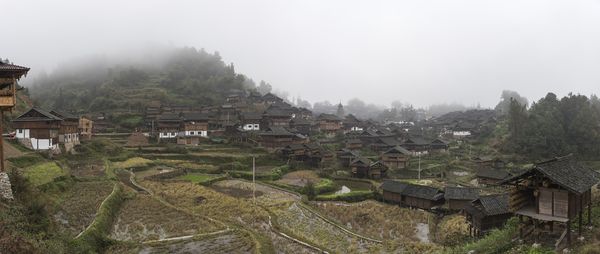

أقامت قويتشو بصورة أولية هيكلا اقتصاديا يبرز تفوق موارد المقاطعة والتكنولوجيا بحيث تكون الطاقة والمواد الخام والماكينات والإلكترونيات والصناعة الخفيفة والغزل والنسيج القوام الرئيسي له. صناعة الخمور وصناعة السجائر، أشهر الصناعات الخفيفة بها.
تتوفر في قويتشو موارد الطاقة باحتياطي كبير، وهي تجمع بين الطاقة المائية والحرارية. وفقا لخطة الدولة لنقل كهرباء الغرب إلى الشرق، بدأ بناء سلسلة من المحطات الكهرومائية بها. يبلغ احتياطي الفحم في قويتشو 6ر52 مليار طن، ولهذا تسمى "بحر الفحم في جنوب نهر اليانغتسي". وتزخر قويتشو بالموارد المعدنية ذات الاحتياطي الكبير والجودة العالية والتوزيع المتمركز، خاصة بوكسيت الفاناديوم وصخور الفسفور والأنتيمون والمنغنيز والذهب، وتم بناء أكبر مصنع للألمونيوم المحلل كهربائيا في الصين وأكبر قاعدة لسماد الفوسفور وأكبر قاعدة لإنتاج وتصدير مواد الصقل والماس الصناعي في الصين بها. إلى جانب ذلك فيها مجال واسع لتطوير الأدوية البيولوجية والأطعمة المتميزة.[19]
تم بناء شبكة نقل شاملة في قويتشو، مركزها مدينة قوييانغ، وتتكامل السكة الحديد والطرق العامة والطيران والنقل النهري بعضها مع بعض، وقد مدت السكة الحديد التي تربط سيتشوان ويوننان وقويتشو وقوانغشي إلى شاطئ البحر.
في قويتشو مناظر جبلية ومائية غريبة وعادات وتقاليد متميزة للأقليات القومية، ولهذا فإن ثمة مستقبلا مشرقا للخطوط السياحية والمناظر السياحية الجديدة وإنشاءات الخدمات ومرافق التسلية وغيرها من المشروعات. في قويتشو أنواع كثيرة من الموارد البيولوجية المتميزة، فهي إحدى المناطق الكبيرة لإنتاج العقاقير الطبية التقليدية الصينية.
بعد أن تبنت الحكومة الصينية خطة تنمية المناطق الغربية تخطط قويتشو لتصبح ممرا جنوبيا مؤديا إلى البحر وهمزة وصل للمواصلات البرية لجنوب غربي الصين، وحاجزا بيئيا هاما على المجاري العليا لنهري اليانغتسي واللؤلؤ، وقاعدة هامة للطاقة والمواد الخام بجنوب الصين، وقاعدة لصناعات التكنولوجيا العالية والحديثة يمثلها الطيران والفضاء والمعلومات الإلكترونية والتكنولوجيا البيولوجية.
مدينة قوييانغ عاصمة قويتشو هي المركز السياسي والاقتصادي والثقافي للمقاطعة.
التقسيمات الإدارية
تنقسم گويژو إلى 9 تقسيمات على مستوى محافظة، 88 تقسيم على مستوى ناحية ، و1543 تقسيم على مستوى بلدة.
Guizhou is made up of 9 prefecture-level divisions, 88 county-level divisions, and 1543 township-level divisions.
التقسيمات الإدارية العشرة في مقاطعة گويژو:
| الخريطة | # | الاسم | هانزي | هانيو پنين | النوع |
|---|---|---|---|---|---|

| |||||
| 1 | بيجيه Bijie | 毕节地区 | Bìjíe Dìqū | محافظة | |
| 2 | زونيي Zunyi | 遵义市 | Zūnyì Shì | مدينة على مستوى محافظة | |
| 3 | تونگرن Tongren | 铜仁地区 | Tóngrén Dìqū | محافظة | |
| 4 | ليوپانشوي Liupanshui | 六盘水市 | Liùpánshuǐ Shì | مدينة على مستوى محافظة | |
| 5 | آنشون | 安顺市 | Ānshùn Shì | مدينة على مستوى محافظة | |
| 6 | گوييانگ Guiyang | 贵阳市 | Guìyáng Shì | مدينة على مستوى محافظة | |
| 7 | Qianxinan (Buyei & Miao) | 黔西南布依族苗族自治州 | Qiánxī'nán Bùyīzú Miáozú Zìzhìzhōu |
محافظة حكم ذاتي | |
| 8 | Qiannan (Buyei & Miao) | 黔南布依族苗族自治州 | Qiánnán Bùyīzú Miáozú Zìzhìzhōu |
محافظة حكم ذاتي | |
| 9 | Qiandongnan (Miao & Dong) | 黔东南苗族侗族自治州 | Qiándōngnán Miáozú Dòngzú Zìzhìzhōu |
محافظة حكم ذاتي |
الديمغرافيا
| السنة | تعداد | ±% p.a. |
|---|---|---|
| 1912[20] | 9٬665٬000 | — |
| 1928[21] | 14٬746٬000 | +2.68% |
| 1936-37[22] | 9٬919٬000 | −4.84% |
| 1947[23] | 10٬174٬000 | +0.23% |
| 1954[24] | 15٬037٬310 | +5.74% |
| 1964[25] | 17٬140٬521 | +1.32% |
| 1982[26] | 28٬552٬997 | +2.88% |
| 1990[27] | 32٬391٬066 | +1.59% |
| 2000[28] | 35٬247٬695 | +0.85% |
| 2010[29] | 34٬746٬468 | −0.14% |
في 1832، the population was estimated at five million.[30] Guizhou is one of the provinces that contains the most minority groups. The minority groups account for more than 37% of the total population and they include Yao, Miao (including Gha-Mu and A-Hmao), Yi, Qiang, Dong, Zhuang, Buyei, Bai, Tujia, Gelao and Shui. 55.5% of the province area is designated as autonomous regions for them. Guizhou is the province with highest TFR in China with 2.19. (Urban-1.31, Rural-2.42) [31]
الدين
The predominant religions in Guizhou are Chinese folk religions, Taoist traditions and Chinese Buddhism. According to surveys conducted in 2007 and 2009, 31.18% of the population believes and is involved in ancestor veneration, while 0.99% of the population identifies as Christian, decreasing from 1.13% in 2004.[32]
The reports did not give figures for other types of religion; 67.83% of the population may be either irreligious or involved in worship of nature deities, Buddhism, Confucianism, Taoism, folk religious sects, and small minorities of Muslims. There are significant ethnic minority populations (the Miao and the Buyei) who traditionally follow their autochthonous religions.
الثقافة
Guizhou is the home of the Moutai Distillery, distillers of Maotai liquor, China's most famous alcoholic beverage. The Chinese name of the distillery is Zhongguo Guizhou Maotai Jiuchang (simplified: 中国贵州茅台酒厂).
السياحة


The province has many covered bridges, called Wind and Rain Bridges. These were built by the Dong minority people.
مرئيات
| جبال الأهرامات في آنلونگ، مقاطعة گوانگشي، الصين. |
ملاحظات
- ^ The data was collected by the Chinese General Social Survey (CGSS) of 2009 and by the Chinese Spiritual Life Survey (CSLS) of 2007, reported and assembled by Xiuhua Wang (2015)[32] in order to confront the proportion of people identifying with two similar social structures: ① Christian churches, and ② the traditional Chinese religion of the lineage (i. e. people believing and worshipping ancestral deities often organised into lineage "churches" and ancestral shrines). Data for other religions with a significant presence in China (Buddhism, Confucianism, deity worships, Taoism, folk religious sects, Islam, religions practiced by ethnic minorities, et. al.) was not reported by Wang.
- ^ This may include:
- البوذية;
- الكونفوشية;
- Deity worshippers;
- الطاوية;
- Members of folk religious sects;
- أقليات ضئيلة من المسلمين؛
- Indigenous religions of the ethnic minorities;
- And people not bounded to, nor practicing any, institutional or diffuse religion.
الهامش
|
وصلات خارجية
- Guizhou government website (in صينية)
- Guiyang Government website Archived 2010-07-12 at the Wayback Machine
- Township level administrative map of Guizhou
- Pages using gadget WikiMiniAtlas
- CS1 الإنجليزية الأمريكية-language sources (en-us)
- Harv and Sfn no-target errors
- CS1 uses اليابانية-language script (ja)
- CS1 uses الصينية-language script (zh)
- Short description is different from Wikidata
- Articles containing صينية-language text
- Coordinates on Wikidata
- Articles containing simplified Chinese-language text
- Articles containing traditional Chinese-language text
- Articles with unsourced statements from November 2022
- Articles with hatnote templates targeting a nonexistent page
- Articles with صينية-language sources (zh)
- گويژو
- مقاطعات الصين
- South China
- Western China



